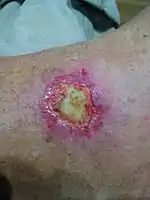Livedoid vasculopathy
| Livedoid vasculopathy | |
|---|---|
| Other names: Livedoid vasculitis, livedo reticularis with summer/winter ulceration, segmental hyalinizing vasculitis[1] | |
 | |
| Specialty | Dermatology |
Livedoid vasculopathy typically presents with painful purplish flat spots and small bumps clustered around the lower legs and ankles.[1] They develop bloody crusts, break down to form ulcers with purplish irregular edges and then heal, when they appear as shiny white thin skinned scars with overlying small blood vessels.[1]
It is a longterm skin condition seen predominantly in young to middle-aged women.[2] One acronym used to describe its features is "painful purpuric ulcers with reticular pattern of the lower extremities" (PURPLE).[1][3]
It can be divided into a primary (or idiopathic) form and a secondary form, which has been associated with a number of diseases, including chronic venous hypertension and varicosities.[4]: 343
 Immature LV ulcer from patient with good circulation
Immature LV ulcer from patient with good circulation.jpg.webp) Livedoid vasculitis
Livedoid vasculitis.jpg.webp) Livedoid vasculitis
Livedoid vasculitis.jpg.webp) Livedoid vasculitis
Livedoid vasculitis
See also
References
- 1 2 3 4 James, William D.; Elston, Dirk; Treat, James R.; Rosenbach, Misha A.; Neuhaus, Isaac (2020). "35.Cutaneous vascular diseases". Andrews' Diseases of the Skin: Clinical Dermatology (13th ed.). Edinburgh: Elsevier. pp. 819–820. ISBN 978-0-323-54753-6. Archived from the original on 2022-10-01. Retrieved 2022-10-01.
- ↑ Johnstone, Ronald B. (2017). "8. Vasculopathic reaction pattern". Weedon's Skin Pathology Essentials (2nd ed.). Elsevier. p. 166. ISBN 978-0-7020-6830-0. Archived from the original on 2021-05-25. Retrieved 2022-09-29.
- ↑ Keshavmurthy A Adya; Arun C Inamadar; Aparna Palit (January–February 2014). "Reticulate Dermatoses". Indian Journal of Dermatology. 59 (1): 3–14. doi:10.4103/0019-5154.123480. PMC 3884924. PMID 24470653.
- ↑ Rapini, Ronald P.; Bolognia, Jean L.; Jorizzo, Joseph L. (2007). Dermatology: 2-Volume Set. St. Louis: Mosby. ISBN 978-1-4160-2999-1.
External links
| Classification | |
|---|---|
| External resources |
This article is issued from Offline. The text is licensed under Creative Commons - Attribution - Sharealike. Additional terms may apply for the media files.